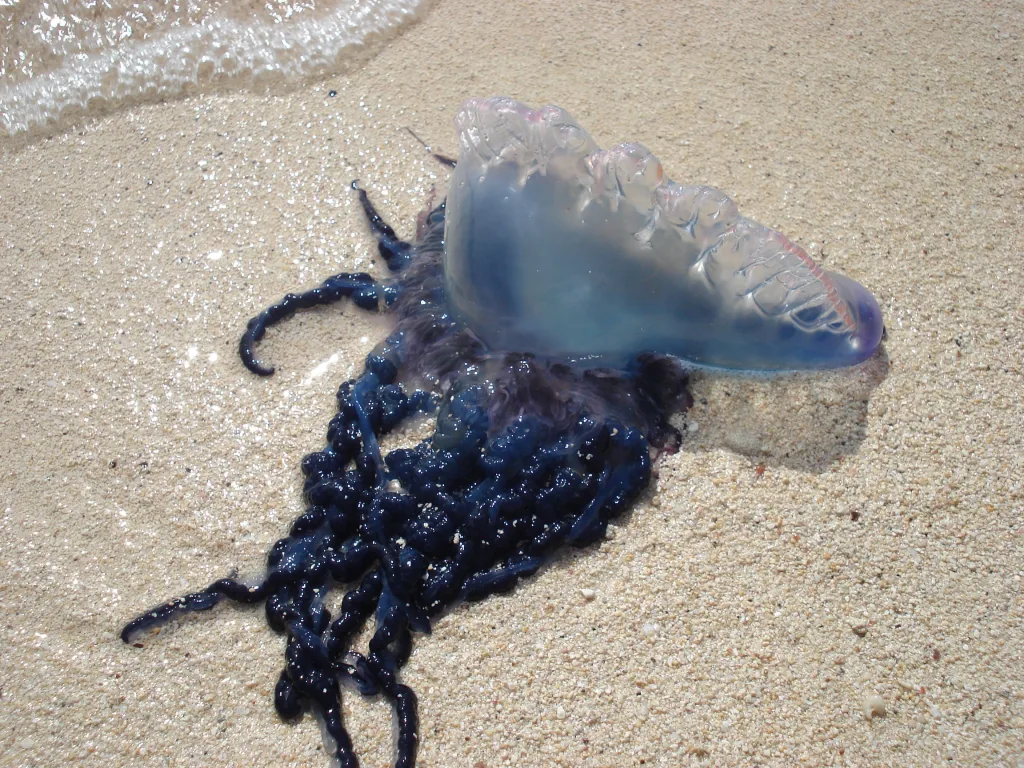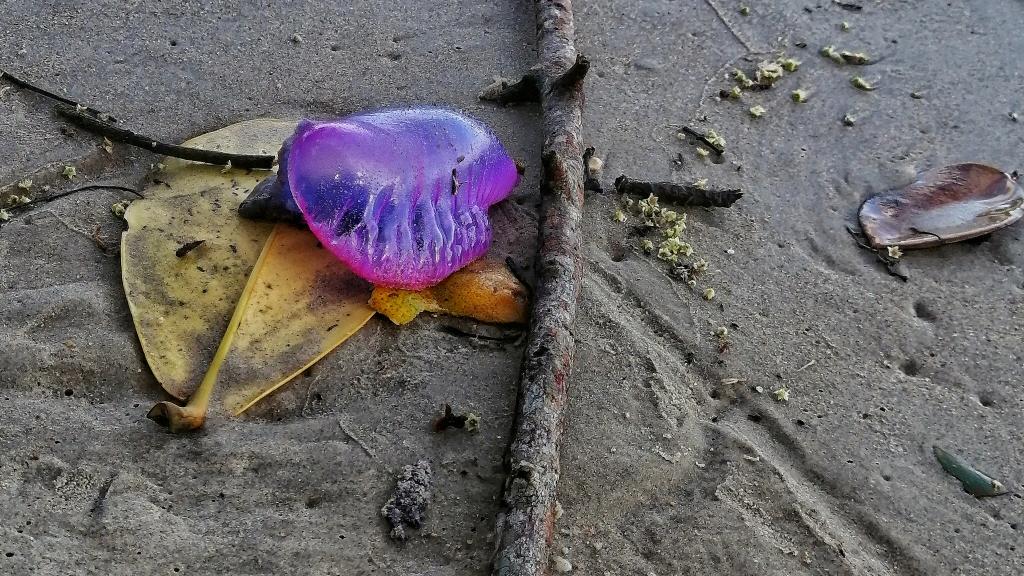The Portuguese Man o’ War, also known as the blue bottle, is a jellyfish-like marine creature that packs an incredibly powerful sting. It is found in tropical and subtropical waters around the world and can be recognized by its bright blue or pinkish-purple float.
Despite its beautiful colors, the Portuguese Man o’ War is one of the most dangerous creatures in the ocean. Its tentacles contain stinging nematocysts which deliver a venomous toxin into their prey. While it rarely kills humans, it can cause severe pain and welts on exposed skin. In some cases, it can even cause anaphylaxis shock or allergic reaction if you are particularly sensitive to its venom.
So how deadly can a Portuguese Man o’ War really be? The answer is not simple. While its sting is rarely fatal to humans, it can be incredibly painful and even life-threatening to small fish and crustaceans. Even dead Portuguese Men o’ War washed up on shore can still deliver a powerful sting if touched or stepped on. For this reason, beachgoers should stay away from these creatures at all costs as even after death they remain dangerous!
Although painful, a Portuguese Man o’ War sting will usually subside within a few hours with proper first aid treatment such as soaking the affected area in hot water or applying ice packs to reduce swelling and pain. If you experience any further reactions such as difficulty breathing or dizziness after being stung then seek medical attention immediately – these cold be signs of anaphylaxis shock which needs to be treated quickly with epinephrine or adrenaline injections.
In conclusion, while a Portuguese Man o’ War sting may not kill you directly, it can cause severe pain and other complications if not treated properly so extreme caution should be taken when near these creatures!
Dangers of Touching a Portuguese Man O War
If you touch a Portuguese Man O War, you may experience an extremely painful sting. This is caused by microscopic stinging cells called nematocysts, which are located in the tentacles of the organism. When these nematocysts come into contact with skin, they fire out a coiled and barbed tube loaded with venom that can paralyze and even kill small fish or crustaceans. While the man o’ war’s sting is rarely fatal to humans, it can cause intense pain and swelling on exposed skin.

Can a Portuguese Man O War Kill a Human with One Tentacle?
No, a Portuguese Man O War cannot kill a human with a single tentacle. The venom in its tentacles is powerful enough to cause excruciating pain and even severe skin irritation and blistering, but it will not be strong enough to kill a healthy adult human. However, this does not mean that the sting of the Portuguese Man O War shoud be taken lightly. In some cases, particularly for those with weaker immune systems or allergies to the venom, the effects can be more serious and even life-threatening. Therefore, it is important to take caution when encountering these creatures and seek medical attention immediately if stung.
The Dangers of the Box Jellyfish: Can It Kill You?
Yes, the box jellyfish can be fatal. Its tentacles are covered in nematocysts, small darts loaded with a powerful venom which can cause paralysis, cardiac arrest, and death within minutes of being stung. The box jellyfish is one of the most venomous creatures in the world and is capable of killing a human in just three minutes. Even those who survive the sting may suffer long-term health complications such as impaired vision or permanent scarring. It is therefore important to take precautions when swimming in areas where box jellyfish may be present.
Surviving a Man O’War Sting
Yes, it is possible to survive a sting from a Man O’War. While the sting may be extremely painful, it is rarely fatal for humans. However, if you are stung by a Man O’War it is important to seek medical attention as soon as possible. Symptoms of a Man O’War sting include intense burning pain, swelling, and redness around the affected area. Some people may experience other symptoms such as nausea, vomiting, or headaches. In severe cases anaphylactic shock can occur and require immedate treatment. It is also important to remove any remaining tentacles from the skin with gloves or tweezers and rinse the affected area with vinegar or seawater. Applying ice can help reduce swelling and using over-the-counter antihistamines can help reduce itching or discomfort.
Can a Dead Man-of-War Sting?
Yes, a man-of-war can still sting when dead. The venomous tentacles of the man-of-war contain stinging cells that can be triggered by contact even after the jellyfish has died. Even if the colony of the man-of-war is dead, its tentacles can still sting and inject venom into any unsuspecting person or animal that touches them. A vinegar rinse or heat treatment can help to inactivate or neutralize any venom present in a tentacle.

Source: animals.howstuffworks.com
The Effects of a Man O War Sting
If you are stung by a Portuguese man-of-war, you may experience an immediate burning pain and redness at the site of contact. The affected area may develop a red line with small white lesions or even blisters or welts that look like a string of beads. In some cases, the sting can cause nausea, headaches, dizziness and other signs of shock. If any of these symptoms occur after being stung, seek medical attention as soon as possible.
The Inaccessibility of the Man O War’s Top
No, you should not touch the top of a man o’ war. It is a species of siphonophore, and although it may look like a single organism, it is actually made up of many individual organisms called zooids. Each zooid has its own specialized function within the colony, and the tentacles on the top contain specialized cells known as nematocysts that can deliver a venomous sting when triggered by touch. This sting can cause intense pain and swelling, and in some cases can even be fatal. So please observe but do not touch!
The Dangers of Touching a Portuguese Man O War
No, you should not touch a Portuguese Man O War. Its venomous tentacles can cause painful stings, skin welts, and even an allergy-like response. If you come across a Portuguese Man O War, it is best to admire it from afar instead of risking the consequences of touching it.
The Most Venomous Sea Creature
The Australian box jellyfish (Chironex fleckeri) is widely considered to be the most venomous sea creature. This species of jellyfish can be found in coastal waters of the Northern Territory, Queensland and Western Australia as well as further afield in the Indo-Pacific region. Measuring up to 20cm in diameter, these tiny creatures have tentacles between 15-30 cm long that contain millions of microscopic stinging cells (known as nematocysts).
The sting of the Australian box jellyfish is incredibly powerful and can result in cardiac arrest, paralysis or even death within minutes. The venom contains a range of toxins including proteins, enzymes and biogenic amines that attack vaious body systems such as the cardiovascular system, nervous system and respiratory system. As well as causing intense pain, swelling and redness at the site of contact, it can lead to nausea, vomiting and dizziness. In some cases a person may also experience difficulty breathing or heart problems and may require urgent medical attention.
For those unlucky enough to encounter this deadly creature, first aid should be sought immediately with pressure immobilisation bandaging recommended for serious stings. For milder stings vinegar should be applied to neutralise any remaining nematocysts on the skin before other treatments are administered.

Source: cayman.loopnews.com
The Most Poisonous Jellyfish
The Irukandji jellyfish is widely regarded as the most poisonous jellyfish in the world. Its sting is extremely potent, and can cause a range of medical complications including fatal brain hemorrhages. The venom of an Irukandji jellyfish is estimated to be 100 times more potent than that of a cobra, and 1,000 times stronger than a tarantula’s. Each year, its sting sends an average of 50-100 people to the hospital for treatment. Fortunately, fatalities from Irukandji stings are rare.
Can Jellyfish Live Indefinitely?
Yes, a certain species of jellyfish called Turritopsis dohrnii is capable of living forever. It was first discovered in 1988 and its ability to regenerate into a polyp—its earliest stage of life—as it ages or when it experiences illness or trauma has earned it the reputation of being “immortal”. The remarkable process involves the jellyfish’s body disintegrating and then reforming as a polyp, which can then mature back into an adult. It is still unclear exactly how the jellyfish is able to accomplish this feat and further research is needed to fully understand this unique species.
Conclusion
In conclusion, the Portuguese Man of War is an incredibly dangerous and venomous species of jellyfish found in oceans around the world. Its tentacles contain stinging nematocysts that are capable of delivering a painful sting, and in rare cases, even death. It has powerful muscles that draw prey up to its digestive polyp, and it should be handled with extreme caution as its toxins can cause paralysis, cardiac arrest, and other serious health issues. Therefore, it is important to stay safe when in or near the ocean by wearing protective clothing and avoiding contact with these jellyfish.
